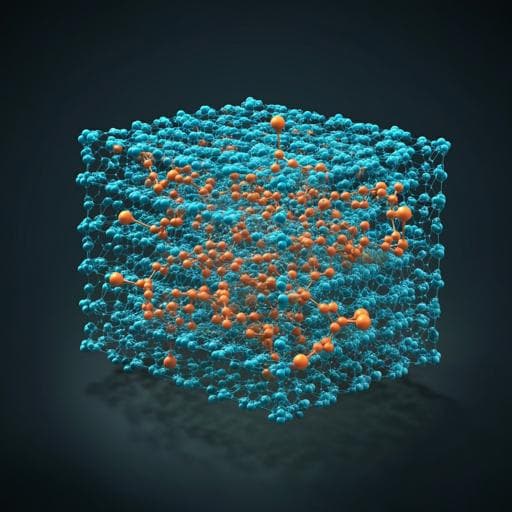
Chemistry
Mixed-linker strategy for suppressing structural flexibility of metal-organic framework membranes for gas separation
C. Chang, T. Ko, et al.
Discover groundbreaking advancements in gas separation using CAU-10-based membranes! This innovative study reveals how a mixed-linker strategy enhances membrane stability and improves CO₂/CH₄ separation performance. Explore the transformative potential of this research conducted by a team of experts from National Taiwan University and Sogang University.
~3 min • Beginner • English
Introduction
Metal-organic frameworks (MOFs) are promising porous crystalline materials for energy-efficient membrane gas separations, including CO₂/N₂ (flue gas) and CO₂/CH₄ (natural gas purification). Prior MOF-based mixed matrix membranes (MMMs) have shown strong performance but require further development for thin-film applications, while relatively few pure MOF membranes achieve high selectivity and permeability simultaneously. The CAU-10 family (aluminum-based MOFs with 1D channels) offers pore-limiting diameters comparable to kinetic diameters of CO₂, N₂, and CH₄. Previous work showed CAU-10-H membranes with high CO₂/CH₄ selectivity and CAU-10-PDC membranes with even higher selectivity but prone to structural deformation upon CH₄ exposure, shrinking PLD and degrading performance. Structural flexibility, well documented in systems like ZIF-8, alters effective aperture sizes and undermines selectivity. This study addresses the research question: can a mixed-linker strategy (combining PDC and BDC linkers) suppress structural flexibility in CAU-10-based membranes to stabilize structure during operation while tuning aperture size and maintaining or improving separation performance? The purpose is to improve stability under mixed-gas conditions, particularly CO₂/CH₄, and to rationalize the origin of stability via in situ characterization and DFT.
Literature Review
- MOF-based MMMs: Y-fum-fcu-MOF in 6FDA-DAM polyimide achieved CO₂/CH₄ selectivity ~30 with CO₂ permeability ~1000 Barrer. UiO-66-CN@sPIM-1 showed CO₂/N₂ selectivity ~55 and permeability ~12,000 Barrer. NUS-8 nanosheets/PIM-1 (2 wt%) delivered CO₂/CH₄ selectivity ~30 and CO₂ permeability ~6500 Barrer. Mg-MOF-74/PIM-1 (20 wt%) gave CO₂/N₂ selectivity ~30 with CO₂ permeability ~11,000 Barrer.
- Pure MOF membranes: IRMOF-1 exhibited CO₂/N₂ and CO₂/CH₄ selectivity >300 and CO₂ permeability ~10,000 Barrer. MIL-160/CAU-10-F reached CO₂/N₂ and CO₂/CH₄ selectivities >30 and >70, with CO₂ permeability ~2000 Barrer. ZIF-94 showed CO₂/CH₄ selectivity ~38 and CO₂ permeability ~28 Barrer.
- Structural flexibility in ZIF-8 leads to larger effective apertures than static PLD suggests; strategies like rapid heat treatment and mixed-linker synthesis have been used to suppress gate-opening and enhance CO₂/N₂ selectivity.
- CAU-10 family: CAU-10-H membranes (PLD ~3.21 Å) previously achieved CO₂/CH₄ selectivity up to 50 and CO₂ permeability 220 Barrer. CAU-10-PDC achieved CO₂/CH₄ selectivity >60 and CO₂ permeability >20 Barrer but suffered CH₄-induced structural deformation (PLD from 4.15 to 2.95 Å). Computational studies also inform MOF selection and transport mechanisms for CO₂ separations.
Methodology
- Synthesis: CAU-10-PDC, CAU-10-H, and mixed-linker CAU-10-PDC-H powders synthesized solvothermally using Al₂(SO₄)₃·18H₂O in water with PDC and/or BDC in DMF, refluxed at 120 °C for 2 days; solvent exchange with MeOH; drying at 100 °C.
- Membrane fabrication: Seeded growth on porous α-alumina (40 mm diameter, 2 mm thickness, 34% porosity). Spin-on deposition of 0.2 wt% MOF seed suspensions (3 times at 2000 rpm, 30 s) followed by secondary growth in Teflon-lined autoclave at 100 °C for 24 h using mixed PDC/BDC linker feeds to achieve target ratios (e.g., 7:3, 5:5, 3:7; also pure PDC and pure BDC). Post-treatment with MeOH, drying at 100 °C.
- Characterization: FTIR (ATR, 4 cm⁻¹ resolution) to identify linker incorporation; liquid-state ¹H NMR (Bruker AVIII 500 MHz, D₂O/NaOD) to quantify PDC/BDC ratios; elemental analysis (CHN) to corroborate compositions. SEM (Hitachi S4800) for membrane morphology and thickness (~10 µm) and crystal intergrowth.
- Structural analysis: Ex situ XRD (Rigaku SmartLab SE, Cu Kα); Rietveld refinement for PLD of pure phases (CAU-10-H ~3.21 Å; CAU-10-PDC ~4.15 Å). In silico models for mixed-linkers (ratios 8:2, 5:5, 2:8) optimized using CASTEP (PBE-GGA, ultrasoft pseudopotentials, 340 eV cutoff). PLD and PSD from optimized structures using Zeo++ (50,000 MC samples; probe radius 1.1 Å).
- In situ time-resolved XRD: Synchrotron (TPS 19A, λ=0.77489 Å) under 2 bar CH₄ at 35 °C; degas at 70 °C, 0.005 bar; collect patterns every 12 min up to 120 min with MYTHEN detector to monitor (200)/(101) peak shifts.
- In situ DRIFT spectroscopy: Bruker Tensor 27 with MCT detector, 32 scans, 4 cm⁻¹ resolution; sequential CH₄ and CO₂ adsorption after overnight vacuum; monitor μ-OH and C–N vibrational shifts to assess adsorption-induced structural changes.
- Gas sorption: CO₂, N₂, CH₄ adsorption at 35 °C (pressure decay method) to derive sorption coefficients; N₂ adsorption at 77 K (ASAP2020) with ESW+BET analysis for surface area.
- Gas permeation: Constant-volume method at 35 °C. Single-gas permeability at 2 bar partial pressure for H₂, CO₂, N₂, CH₄; ideal selectivities from single-gas data. Mixed-gas tests for CO₂/N₂ and CO₂/CH₄ (50/50 mol, total 2 bar) with permeate analysis by GC-TCD (Shincarbon-ST). Separation factor computed from permeate/feed compositions. Diffusion coefficients inferred from permeability and sorption coefficients.
- DFT vibrational analysis: VASP (PBE-GGA, PAW, 450 eV cutoff, 2×2×4 k-mesh) on CAU-10-PDC as-made and deformed structures to assign μ-OH and C–N frequency shifts.
- Energy decomposition analysis (EDA): CP2K Quickstep (PBE-D3, MOLOPT DZVP basis, GTH pseudopotentials; plane-wave cutoff 450 Ry, relative 60 Ry) to decompose binding energy into interaction and deformation components for methane adsorption on CAU-10-PDC and CAU-10-H.
Key Findings
- Mixed-linker strategy suppresses structural flexibility: Partial substitution of PDC with BDC (30 mol% BDC; CAU-10-PDC-H 70/30) markedly stabilizes the framework under CH₄, mitigating the severe deformation seen in pure CAU-10-PDC.
- Tunable pore aperture: Simulations show PLD increases with PDC content; PSD narrows at higher PDC ratios. Experimental PLDs: CAU-10-H ~3.21 Å; CAU-10-PDC ~4.15 Å. Pure CAU-10-PDC deforms to PLD ~2.95 Å after CH₄ exposure.
- Membrane performance (35 °C, 2 bar feed): CAU-10-PDC-H (7:3) achieved CO₂/CH₄ separation factor 74.2 and CO₂ permeability 1,111.1 Barrer (mixed gas, 50/50). It also delivered top performance for CO₂/N₂ among tested ratios and outperformed many MOF membranes in Robeson-type plots. CAU-10-PDC-H (5:5) also performed strongly; CAU-10-PDC-H (3:7) was less permeable with lower separation.
- Mixed-gas behavior: Separation factors for CO₂/N₂ and CO₂/CH₄ exceeded ideal selectivities; N₂ and CH₄ permeabilities dropped relative to single-gas values due to competitive adsorption-diffusion. CH₄ slightly decreased CO₂ permeability relative to CO₂/N₂ mixtures.
- Diffusion-dominated selectivity: Sorption coefficients for CO₂, N₂, CH₄ were similar across mixed-linker samples, but diffusion coefficients differed, with CAU-10-PDC-H (7:3) showing the highest CO₂ diffusion, explaining its superior permeability/selectivity.
- Stability under operation: Long-term mixed-gas tests (hours) showed stable permeability and separation factors for CAU-10-PDC-H (7:3) in both CO₂/N₂ and CO₂/CH₄; only slight CH₄ permeability decrease (<2×) observed for 5:5 and 7:3, contrasting with an order-of-magnitude CH₄ permeance drop previously seen in pure CAU-10-PDC.
- In situ XRD: Under 2 bar CH₄ at 35 °C, mixed-linker MOFs (7:3, 5:5, 3:7) exhibited no significant (200)/(101) peak shifts (only intensity changes from adsorption), whereas pure CAU-10-PDC showed clear (200) shift corresponding to PLD collapse (4.15→2.95 Å).
- In situ DRIFT: CAU-10-PDC displayed strong red shift (~100 cm⁻¹) and broadening of μ-OH and blue shift of C–N upon CH₄ adsorption, indicating structural change. In CAU-10-PDC-H (7:3), μ-OH red shift was transient (peaked within 3 min, then diminished) and C–N blue shift was negligible; CAU-10-H showed no shifts. Similar but smaller effects were observed under CO₂.
- EDA insights: Methane adsorption on CAU-10-PDC favors deformation (binding energy with induced deformation −2.58 kcal mol⁻¹); CAU-10-H disfavors deformation (positive 1.69 kcal mol⁻¹). PDC–CH₄ interaction energy (−11.7 kcal mol⁻¹) is stronger than BDC–CH₄ (−6.45 kcal mol⁻¹). The energy release upon adsorption in CAU-10-PDC can overcome the ~9.12 kcal mol⁻¹ deformation cost, while partial BDC substitution reduces adsorption energy release, lowering deformation propensity.
- Additional ratio: CAU-10-PDC-H (8:2) had high CO₂ permeability (>1000 Barrer) but low separation factor (<20), consistent with an overly large PLD (~4.10 Å) permitting facile passage of all gases.
Discussion
The study demonstrates that structural flexibility, which previously led to performance degradation in pure CAU-10-PDC under CH₄, can be suppressed by a mixed-linker approach. Replacing 30 mol% of PDC with BDC in CAU-10 tunes the interaction strength with adsorbates and increases lattice rigidity, preventing adsorption-induced pore collapse while maintaining an aperture conducive to CO₂ molecular sieving. In situ XRD and DRIFT directly correlate gas exposure with minimal structural changes in mixed-linker membranes, while DFT vibrational analysis and EDA elucidate the energetic basis for stabilized behavior (reduced interaction energy and deformation driving force). Transport analysis indicates that diffusion, rather than sorption, differentiates performance among ratios, with CAU-10-PDC-H (7:3) offering the optimal balance of PLD, narrow PSD, and surface area for high CO₂ permeability and selectivity. These findings address the central hypothesis that mixed-linker design can enhance membrane operational stability and performance for CO₂ separations and position CAU-10-PDC-H (7:3) as a leading MOF membrane surpassing many literature benchmarks.
Conclusion
A mixed-linker CAU-10 strategy effectively suppresses structural flexibility that undermines gas separation performance in pure CAU-10-PDC membranes. Incorporating 30 mol% BDC into CAU-10-PDC stabilizes the framework against CH₄-induced deformation while fine-tuning pore size and distribution. The optimized CAU-10-PDC-H (70/30) membrane achieves a CO₂/CH₄ separation factor of 74.2 and CO₂ permeability of 1,111.1 Barrer at 35 °C and 2 bar, with stable performance over time. In situ XRD/DRIFT and DFT/EDA analyses reveal that reduced host–guest interaction energy and increased lattice rigidity underpin the enhanced stability. This mixed-linker approach provides a generalizable route to engineer MOF membrane apertures and suppress flexibility for high-performance CO₂ separations. Future work could explore broader linker chemistries, extended operating conditions (higher pressures, humid streams), and scale-up to thin-film composites for industrial implementation.
Limitations
- Computational structural models used ratios 8:2, 5:5, and 2:8 rather than exactly 7:3 and 3:7 due to construction challenges, which may introduce minor discrepancies relative to experimental compositions.
- Gas permeation tests were conducted at a single temperature (35 °C) and moderate pressure (2 bar total), limiting assessment under varying industrial conditions (higher pressures, humidity, impurities).
- Long-term stability measurements spanned hours; extended durability and cycling under realistic gas mixtures were not reported.
- Membrane performance statistics were based on the three most effective membranes with a small sample size (<10), which may not capture batch-to-batch variability.
- Structural deformation analysis focused on CH₄ and CO₂; behavior with other gases/hydrocarbons was not examined.
- The exact microstructure at grain boundaries and its evolution under operation were inferred but not directly imaged in situ.
Related Publications
Explore these studies to deepen your understanding of the subject.







